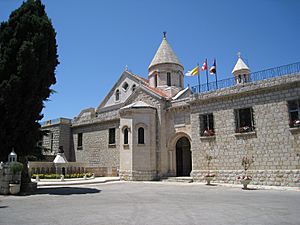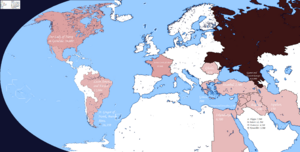Armenian Catholic Church facts for kids
Quick facts for kids Armenian Catholic Church |
|
|---|---|
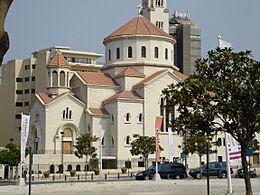
Cathedral of Saint Elias and Saint Gregory the Illuminator in Beirut, the seat of the Armenian Catholic Patriarchate of Cilicia.
|
|
| Classification | Eastern Catholic |
| Theology | Catholic theology |
| Polity | Episcopal |
| Pope | Francis |
| Patriarch | Raphaël Bedros XXI Minassian |
| Region | Armenian diaspora |
| Headquarters | Cathedral of St Elias and St Gregory the Illuminator, Beirut, Lebanon |
| Founder | Abraham Petros I Ardzivian |
| Origin | 1742 Ottoman Empire (modern Armenia) |
| Separated from | Armenian Apostolic Church |
| Members | 150,000 (independent estimates) 757,726 (2017 Annuario Pontificio) |
The Armenian Catholic Church is a special part of the Catholic Church. It is called an Eastern Catholic Church. This means it follows its own traditions and rules, but it also accepts the Pope as its leader.
The Armenian Catholic Church is in full agreement with the main Catholic Church. This includes the Latin Church and 22 other Eastern Catholic Churches. The Church follows its own set of rules, known as Eastern canon law.
The leader of the Armenian Catholic Church is called the Armenian Catholic patriarch of Cilicia. His main church is the Cathedral of Saint Elias and Saint Gregory the Illuminator in Beirut, Lebanon.
Armenian Caritas is a group that helps people. It is the official aid organization of the Catholic Church in Armenia.
Contents
History of the Armenian Catholic Church
The Armenian Apostolic Church had some disagreements with a big meeting called the Council of Chalcedon in 451. They officially separated from other churches in 610.
Early Connections with the Catholic Church
Some Armenian leaders tried to reunite with the Catholic Church later on. During the Crusades in 1198, the Church in the Armenian kingdom of Cilicia joined with the Catholic Church. However, this union did not last very long.
The union was tried again in 1439 at the Council of Florence. But for many centuries, this did not have a big impact. Some Armenians became Catholic during this time. They often joined the Latin Church because there was no specific Armenian Catholic Church yet.
In medieval China, some Armenians became Catholic. This happened in cities like Beijing and Quanzhou.
Founding the Armenian Catholic Church
In 1740, a man named Abraham Petros I Ardzivian became Catholic. He was then chosen as the leader, or patriarch, in a place called Sis. Two years later, in 1742, Pope Benedict XIV officially started the Armenian Catholic Church.
In 1749, the Armenian Catholic Church built a special building called a convent in Bzoummar, Lebanon. Later, during the Armenian genocide from 1915 to 1918, many members of the Church had to move. They went to nearby countries like Lebanon and Syria.
Armenian Catholics in Europe
An Armenian Catholic group also formed in Poland in the 1630s. Their bishop, Mikołaj Torosowicz, joined with the Catholic Church. This community was mainly in Galicia. After World War II, many moved to modern-day Poland. Today, they have three churches in Poland.
There were also Armenians who became Catholic in Transylvania. They blended in with Hungarian culture. Their descendants are now part of the Armenian community in Romania.
Worship and Traditions
The Armenian Catholic Church uses the Armenian Rite for its worship. This way of worship developed a long time ago. It is based on the teachings of Saint Gregory the Illuminator. He was the founder and special saint of the Armenian Church.
Both the Armenian Apostolic Church and the Armenian Catholic Church use this rite. Armenian churches usually have fewer icons than some other Eastern churches. But like some other Eastern churches, they have a screen that hides the priest and the altar during parts of the service.
Armenian Catholic Communities Worldwide
The Armenian Catholic Church has communities in many places. Besides Armenia, Georgia, and Russia, many Armenian Catholics live in the Armenian diaspora. This means they live in countries all over the world. Important communities are in Lebanon (where the Church's main office is), Syria, Egypt, Turkey, Iran, France, the U.S.A., Canada, Argentina, Uruguay, and Australia.
Communities in Eastern Europe
Armenian Catholics first came from areas that are now Armenia, Georgia, and Eastern Europe. In the late 1920s, many Armenian Catholics had to leave their homes.
After the Soviet Union ended in 1991, Pope John Paul II combined the communities in Georgia and Russia with those in Armenia. He created a new area called the Ordinariate for Catholics of Armenian Rite in Eastern Europe. Its main office is in Gyumri, Armenia. This city was chosen because most Catholic Armenians live in northern Armenia.
In 1992, the leader of the Armenian Apostolic Church, Vasken I, said that the Armenian Catholic Church should not be in Armenia.
Today, Catholic Armenians in Georgia live in Akhaltsikhe and nearby villages. They also live in the Akhalkalaki and Ninotsminda regions. These communities are often in rural areas. Their shared Catholic history is a strong bond.
A small school for priests was started in Gyumri, Armenia, in 1994. Students there do their first studies. Then they go to the Pontifical College of the Armenians in Rome for more advanced studies.
There are also many Armenian Catholics in Russia. This is because many Armenians have moved to Russia since the Soviet Union broke apart.
Communities in North America
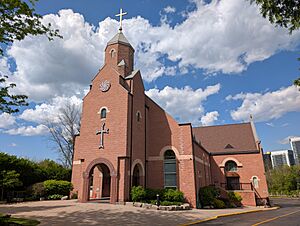
About 1.5 million Armenians live in North America. Around 35,000 of them are part of the Armenian Catholic Church.
In the 1800s, Catholic Armenians came to the United States looking for jobs. Many came from towns like Karin and Mardin. By the end of that century, many who survived the Hamidian massacres settled in U.S. cities. New York City was a main hub.
Armenian Catholic groups also started in New Jersey, Boston, Detroit, and Los Angeles. Educational groups were also formed. In Philadelphia and Boston, Armenian sisters started colleges. These schools taught hundreds of children. Later, a similar college opened in Los Angeles. The Mekhitarists were very focused on keeping Armenian identity alive. They helped start the Mekhitarian College in Los Angeles.
Many Armenians moved to the United States and Canada from Lebanon and Syria in the 1970s. Also, many Catholic Armenians moved from Argentina due to economic problems there. At the same time, many Catholic Armenians moved within the United States. They went to cities like San Francisco, San Diego, Chicago, and Washington, D.C..
In 2005, Pope Benedict XVI made the Catholic area for the USA and Canada into a larger diocese. This diocese serves 35,000 Catholic Armenians in the United States and about 10,000 in Canada. In 2011, Pope Benedict XVI named Mikaël Antoine Mouradian as the new bishop for the Eparchy of Our Lady of Nareg in New York.
Communities in France
France has a large number of Armenian Catholics outside the Middle East and Eastern Europe. The Eparchy of Sainte-Croix-de-Paris was created in 1960.
There are about 30,000 Armenian Catholics in this area. Their main church is the Cathedral of the Holy Cross in Paris. They also have six other churches in different cities. A group of Mekhitarist Fathers lives in Sèvres. A convent of Armenian Sisters of the Immaculate Conception runs a school in Marseille.
Communities in Brazil
The Catholic Armenian Community of São Paulo started in 1935. It was called the Chaplaincy of the Catholic Armenian Mission. This was to help Armenian immigrants who had moved to Brazil since 1923. Most of them came from a city in Turkey called Marach. Their church is located at Tiradentes Avenue #718.
How Many Armenian Catholics Are There?

In the 1800s, estimates for Armenian Catholics worldwide ranged from 40,000 to 150,000. In 1911, there were about 136,400.
Today, independent groups estimate there are about 150,000 Catholic Armenians. Large communities are found in Lebanon, Iraq, Iran, Turkey, Jerusalem, France, and the United States.
Church Structure
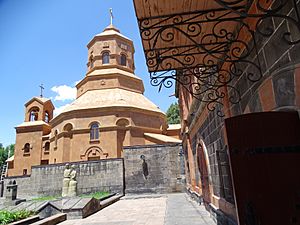
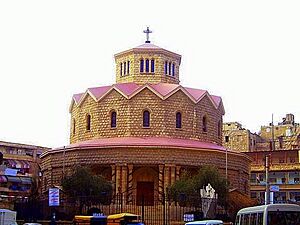

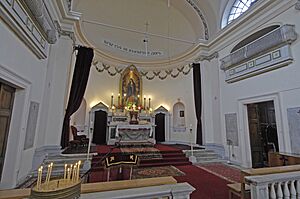
The Armenian Catholic Church is organized into different areas. These areas are called Archdioceses, Eparchies, and Apostolic Exarchates. Each of these areas works like a diocese, which is a church district.
Current Leadership
The Armenian Catholic Patriarchate of the See of Cilicia is the highest authority of the Armenian Catholic Church. On September 23, 2021, Raphaël Bedros XXI Minassian was chosen as the new patriarch.
Here is a list of some of the main areas and their number of members:
| Main Church Areas (Archdioceses) | 1990 | 2000 | 2017 |
|---|---|---|---|
| Patriarchate of Cilicia, also main area in Beirut, Lebanon | 15,000 | 12,000 | 12,500 |
| Aleppo, Syria | 15,000 | 17,000 | 7,000 |
| Baghdad, Iraq | 2,200 | 2,000 | 2,400 |
| Istanbul, Turkey | 3,700 | 3,680 | 2,500 |
| Lviv, Ukraine | N/A | N/A | 0 |
| Smaller Church Areas (Eparchies) | |||
| Ispahan, Iran | 2,200 | 2,200 | 150 |
| Alexandria (in Cairo), Egypt | 1,500 | 1,287 | 6,500 |
| Kameshli, Syria | 4,303 | 4,000 | 3,500 |
| Other Church Areas in the World | |||
| Our Lady of Nareg in the USA and Canada | 34,000 | 36,000 | 36,000 |
| Sainte-Croix-de-Paris, France | 30,000 | 30,000 | 35,000 |
| Saint Gregory of Narek, Buenos Aires | started in 1989 | 16,000 | 16,350 |
| Missionary Areas (Apostolic Exarchates) | |||
| Armenian Catholic Apostolic Exarchate of Latin America and Mexico | 30,000 | 12,000 | 12,000 |
| Areas for Eastern Rite Followers | |||
| Greece (Athens) | 650 | 600 | 200 |
| Romania (Gherla) | N/A | 1,000 | 626 |
| Eastern Europe (except Romania) (Gyumri, Armenia) | started in 1991 | 220,000 | 618,000 |
| Patriarchal Missionary Areas | |||
| Damascus, Syria | 9,000 | 8,000 | 4,500 |
| Jerusalem and Amman (Jordan & Holy Land) | N/A | 280 | 500 |
| TOTAL | 142,853 | 362,047 | .. |
See also
 In Spanish: Iglesia católica armenia para niños
In Spanish: Iglesia católica armenia para niños
- Armenian Apostolic Church
- Catholic Church in Armenia
- List of Armenian Catholic Patriarchs of Cilicia
- Mechitarist Monks
- Ignatius Maloyan
- Gregorio Pietro Agagianian
- Religion in Armenia




